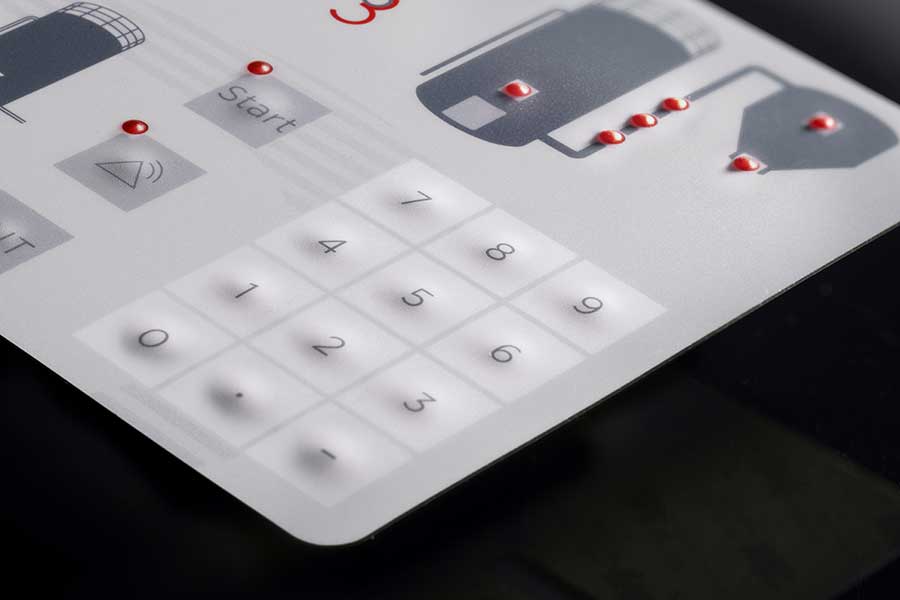Membrane Switches vs. Conventional Switches: What You Need to Consider
Membrane Switches vs. Conventional Switches: What You Need to Consider
Blog Article
Why Membrane Changes Are Vital for Durable Control Systems
Membrane buttons play a crucial duty in making certain the toughness and integrity of control systems across various industries. As we check out the multifaceted benefits of membrane buttons, it becomes obvious that their value transcends plain performance, affecting customer experience and operational efficiency.
Overview of Membrane Layer Buttons
Membrane switches are functional and trusted elements commonly made use of in numerous electronic control systems. These buttons include numerous layers, consisting of a visuals overlay, a spacer layer, and a published circuit layer. The graphic overlay offers both useful and visual layout, while the spacer layer ensures that the buttons are turned on only when pushed. The published circuit layer has conductive traces that finish an electrical circuit when the membrane layer is pushed, enabling the tool to reply to user inputs.
Membrane layer buttons are commonly favored in applications calling for a compact and lightweight style, making them suitable for portable devices, medical tools, and industrial equipment. They can be tailored to meet details individual demands and can incorporate different functions such as backlighting, responsive comments, and several shades. Membrane buttons are immune to dust, wetness, and pollutants, making them appropriate for atmospheres where toughness is important.
Advantages of Sturdiness
In numerous applications, the longevity of membrane switches deals considerable advantages that boost their total efficiency and reliability. These buttons are developed to hold up against severe atmospheres, making them optimal for use popular problems such as high humidity, severe temperature levels, and direct exposure to chemicals. Their durable building helps to stop damages from physical impact, ensuring long-lasting performance and reducing the demand for constant replacements.
In addition, membrane buttons are immune to damage, which is crucial in applications where constant communication takes place. This sturdiness equates to decrease upkeep costs, as companies benefit from reduced downtime and less service disruptions. The encapsulated layout of membrane layer changes safeguards interior elements from dust and dampness ingress, additional contributing to their life expectancy (membrane switch).
An additional advantage is their ability to maintain regular efficiency with time. With a high resistance for mechanical anxiety, these switches preserve their responsive comments and electric integrity, guaranteeing individual satisfaction. Eventually, the sturdiness of membrane switches over not only improves operational performance but likewise cultivates self-confidence in their dependability, making them a preferred selection for control systems throughout numerous fields.
Applications in Different Industries
Resilient control systems utilizing membrane buttons locate extensive applications throughout a series of sectors, each taking advantage of the one-of-a-kind characteristics these switches provide. In the clinical market, membrane buttons are crucial for tools such as individual monitors and analysis devices, where reliability and ease of cleansing are vital. Their resistance to wetness and contaminants guarantees they preserve performance in sterile atmospheres.
The auto industry leverages membrane layer buttons for control panel controls and infotainment systems, where they give sleek, inconspicuous user interfaces that boost customer experience. These buttons are additionally designed to stand up to extreme conditions, consisting of direct exposure to severe temperature levels and vibrations.
In commercial settings, membrane buttons are generally used in machinery control board, providing tactile feedback and toughness needed for high-usage applications. Their capability to stand up to chemicals makes them suitable for manufacturing atmospheres where spills and impurities are constant.

Customer electronic devices, such as kitchen home appliances and remote controls, additionally use membrane layer switches for their flexibility and cost-effectiveness. Generally, the versatility and robust nature of membrane layer changes make them indispensable throughout numerous sectors, making certain effective operation and longevity in control systems.
Style and Visual Allure
While functionality is critical, the layout and visual allure of control systems equipped with membrane switches play a crucial role in user engagement and general experience (membrane switch). The visual design of these switches can significantly affect user assumption and communication. A well-designed membrane layer button improves the beauty of the tool, making it more attractive to customers and cultivating a connection between the user and the item
Membrane layer switches over use a good deal of adaptability in design, enabling producers to personalize graphics, shades, and appearances to straighten with brand identity and item visual appeals. Using dynamic shades and distinct patterns can draw attention, while tactile comments can reinforce the customer's interaction with the tool. In addition, the ability to integrate LED indications and backlighting right into the membrane layer switch design gives both functional and aesthetic advantages, enhancing visibility and usability in various settings.

Enhancing User Experience

Additionally, membrane layer buttons can be tailored to integrate visual user interfaces, boosting usability by offering info in a clear and intuitive fashion (membrane switch). This customization can consist of icons, tags, and shade coding that guide customers via complex capabilities with ease. Additionally, their versatility permits combination in various environments, ensuring regular efficiency whether in industrial equipment or customer electronics
The resilience of membrane layer buttons likewise plays a critical function in individual experience. By withstanding extreme conditions and extended usage, these buttons lower the chance of system failures, thus advertising dependability and user confidence. Inevitably, the critical use membrane layer changes not only boosts performance yet additionally considerably enhances individual communication with control review systems, making them an indispensable component in contemporary layout.
Final Thought

Report this page